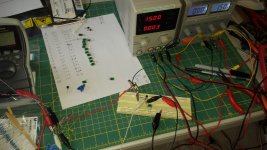Can I get an extra set of eyes on this?
Are the two B-grade BF861 Jfets listed exactly the same?
bf861 NXP RF JFET Transistors | Mouser
thanks.
Are the two B-grade BF861 Jfets listed exactly the same?
bf861 NXP RF JFET Transistors | Mouser
thanks.
The ,215 parts come on a reel of 3,000. The ,235 parts come on a reel of 10,000. If you are producing large numbers of final product, you may find that ordering a reel of 10K gives you different statistics for part-to-part variation than three or four reels of 3,000. If you are buying a couple of dozen for your personal projects, I suspect the difference is irrelevant.
I wimped out and only picked up 25 qty BF861 and 25 qty J113. Also 50 SOT-23 to SIP adapters. Still have a bunch of 2SK170 ranging from 3mA to over 20mA Idss.
Soekris DAC's output is off the R2R array and said to be 1.2V. Can a buffer be made with 15v rails that will produce at least that much output from the buffer?
B1 does it with +19v, so I'm guessing +/-15v rails can achieve at least 1.2v output.
Soekris DAC's output is off the R2R array and said to be 1.2V. Can a buffer be made with 15v rails that will produce at least that much output from the buffer?
B1 does it with +19v, so I'm guessing +/-15v rails can achieve at least 1.2v output.
Question about matching
When matching jfet Idss, when is the reading taken?
Is it the first mA reading one sees or after a certain amount of time or certain temp the jfet reaches?
I noticed the mA reading changes over time.
When matching jfet Idss, when is the reading taken?
Is it the first mA reading one sees or after a certain amount of time or certain temp the jfet reaches?
I noticed the mA reading changes over time.
Correct.
And if you use a heatsink (for thermal coupling), then it is best to test it as such.
But we are getting towards perfection now .....
Patrick
And if you use a heatsink (for thermal coupling), then it is best to test it as such.
But we are getting towards perfection now .....
Patrick
I tested ten J113 jfets so far and lowest Idss so far is 17.17mA at 15v.
Can source resistance help?
Can source resistance help?
Built the buffer from figure C. Used 2sk170 with 9.76 idss on top and a BF861 with 9.64 idss on the bottom. Offset is 63mV.
Ran audio through the buffer to an amp and speakers, and then shut off the buffer and audio stopped. It works! Had this thought that the signal might somehow bleed thru to the amp, but it didn't. 😀
Ran audio through the buffer to an amp and speakers, and then shut off the buffer and audio stopped. It works! Had this thought that the signal might somehow bleed thru to the amp, but it didn't. 😀
Attachments
You can use a higher Idss BF861 for the current source and trim its current with a source resistor.
Then you have a better chance to come below 63mV opffset, which is a lot for a JFET follower.
For other hints, refer to these :
https://www.diyaudio.com/forums/pass-labs/140488-b1-turbo-chip-3.html#post5740480
(post #136)
NJFETs for Source Follower Applications
Patrick
Then you have a better chance to come below 63mV opffset, which is a lot for a JFET follower.
For other hints, refer to these :
https://www.diyaudio.com/forums/pass-labs/140488-b1-turbo-chip-3.html#post5740480
(post #136)
NJFETs for Source Follower Applications
Patrick
No cap. I let the circuit run for 1 hour.
Thought someone said a cap on the output would degrade a simple circuit like this?
I have the higher idss j113, but they are in the 20mA range. The bf861-b are pretty much 6mA to 10mA range, for the 15 pieces I tested. I might have 2sk170s that are 15mA or more. Part of the fun is using jfets that are available for not a lot of money. 🙂
For the dropping resistor, are there any other considerations besides simple ohms law?
I'll check out the links. Thx.
Thought someone said a cap on the output would degrade a simple circuit like this?
I have the higher idss j113, but they are in the 20mA range. The bf861-b are pretty much 6mA to 10mA range, for the 15 pieces I tested. I might have 2sk170s that are 15mA or more. Part of the fun is using jfets that are available for not a lot of money. 🙂
For the dropping resistor, are there any other considerations besides simple ohms law?
I'll check out the links. Thx.
will cap degrade or not is one issue , while completely other issue is output DC offset, of much greater importance to solve , even with cap if there is no other way
do what Patrick wrote - choose adquate specimens for CCS , then introduce source pot to set Iq , thus output offset
it must be close to 0 , except when you deliberately are choosing different voltage level , but even then you must make it in a way that it's settable
do what Patrick wrote - choose adquate specimens for CCS , then introduce source pot to set Iq , thus output offset
it must be close to 0 , except when you deliberately are choosing different voltage level , but even then you must make it in a way that it's settable
- Status
- Not open for further replies.
- Home
- Amplifiers
- Pass Labs
- Buffer with Dual N-Ch Jfets and Dual Power Supply


